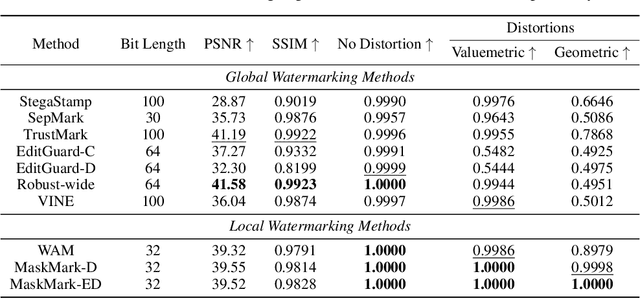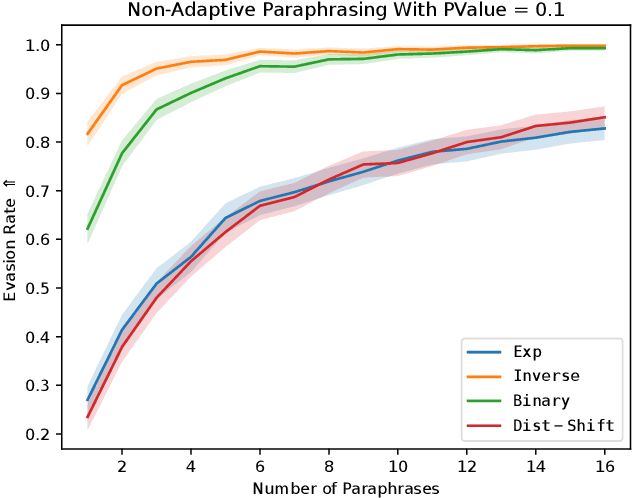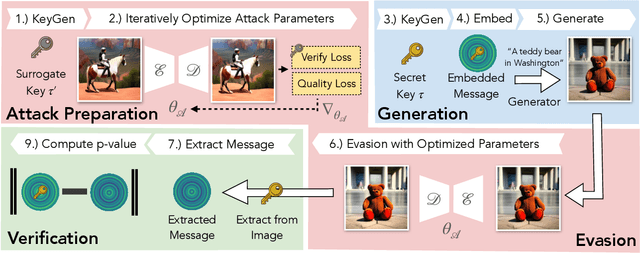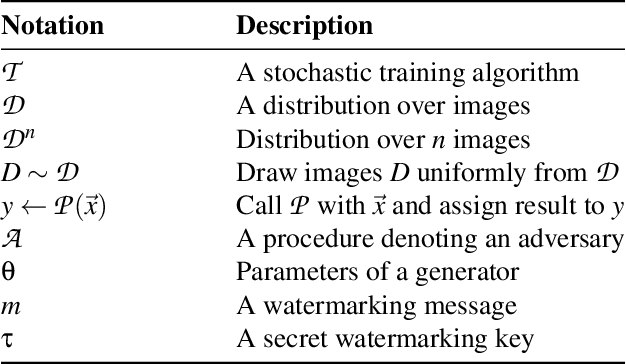Nils Lukas
Robust and Calibrated Detection of Authentic Multimedia Content
Dec 17, 2025Abstract:Generative models can synthesize highly realistic content, so-called deepfakes, that are already being misused at scale to undermine digital media authenticity. Current deepfake detection methods are unreliable for two reasons: (i) distinguishing inauthentic content post-hoc is often impossible (e.g., with memorized samples), leading to an unbounded false positive rate (FPR); and (ii) detection lacks robustness, as adversaries can adapt to known detectors with near-perfect accuracy using minimal computational resources. To address these limitations, we propose a resynthesis framework to determine if a sample is authentic or if its authenticity can be plausibly denied. We make two key contributions focusing on the high-precision, low-recall setting against efficient (i.e., compute-restricted) adversaries. First, we demonstrate that our calibrated resynthesis method is the most reliable approach for verifying authentic samples while maintaining controllable, low FPRs. Second, we show that our method achieves adversarial robustness against efficient adversaries, whereas prior methods are easily evaded under identical compute budgets. Our approach supports multiple modalities and leverages state-of-the-art inversion techniques.
First-Place Solution to NeurIPS 2024 Invisible Watermark Removal Challenge
Aug 28, 2025Abstract:Content watermarking is an important tool for the authentication and copyright protection of digital media. However, it is unclear whether existing watermarks are robust against adversarial attacks. We present the winning solution to the NeurIPS 2024 Erasing the Invisible challenge, which stress-tests watermark robustness under varying degrees of adversary knowledge. The challenge consisted of two tracks: a black-box and beige-box track, depending on whether the adversary knows which watermarking method was used by the provider. For the beige-box track, we leverage an adaptive VAE-based evasion attack, with a test-time optimization and color-contrast restoration in CIELAB space to preserve the image's quality. For the black-box track, we first cluster images based on their artifacts in the spatial or frequency-domain. Then, we apply image-to-image diffusion models with controlled noise injection and semantic priors from ChatGPT-generated captions to each cluster with optimized parameter settings. Empirical evaluations demonstrate that our method successfully achieves near-perfect watermark removal (95.7%) with negligible impact on the residual image's quality. We hope that our attacks inspire the development of more robust image watermarking methods.
Mitigating Watermark Stealing Attacks in Generative Models via Multi-Key Watermarking
Jul 10, 2025Abstract:Watermarking offers a promising solution for GenAI providers to establish the provenance of their generated content. A watermark is a hidden signal embedded in the generated content, whose presence can later be verified using a secret watermarking key. A threat to GenAI providers are \emph{watermark stealing} attacks, where users forge a watermark into content that was \emph{not} generated by the provider's models without access to the secret key, e.g., to falsely accuse the provider. Stealing attacks collect \emph{harmless} watermarked samples from the provider's model and aim to maximize the expected success rate of generating \emph{harmful} watermarked samples. Our work focuses on mitigating stealing attacks while treating the underlying watermark as a black-box. Our contributions are: (i) Proposing a multi-key extension to mitigate stealing attacks that can be applied post-hoc to any watermarking method across any modality. (ii) We provide theoretical guarantees and demonstrate empirically that our method makes forging substantially less effective across multiple datasets, and (iii) we formally define the threat of watermark forging as the task of generating harmful, watermarked content and model this threat via security games.
Mask Image Watermarking
Apr 17, 2025



Abstract:We present MaskMark, a simple, efficient and flexible framework for image watermarking. MaskMark has two variants: MaskMark-D, which supports global watermark embedding, watermark localization, and local watermark extraction for applications such as tamper detection, and MaskMark-ED, which focuses on local watermark embedding and extraction with enhanced robustness in small regions, enabling localized image protection. Built upon the classical Encoder- Distortion-Decoder training paradigm, MaskMark-D introduces a simple masking mechanism during the decoding stage to support both global and local watermark extraction. A mask is applied to the watermarked image before extraction, allowing the decoder to focus on selected regions and learn local extraction. A localization module is also integrated into the decoder to identify watermark regions during inference, reducing interference from irrelevant content and improving accuracy. MaskMark-ED extends this design by incorporating the mask into the encoding stage as well, guiding the encoder to embed the watermark in designated local regions for enhanced robustness. Comprehensive experiments show that MaskMark achieves state-of-the-art performance in global watermark extraction, local watermark extraction, watermark localization, and multi-watermark embedding. It outperforms all existing baselines, including the recent leading model WAM for local watermarking, while preserving high visual quality of the watermarked images. MaskMark is also flexible, by adjusting the distortion layer, it can adapt to different robustness requirements with just a few steps of fine-tuning. Moreover, our approach is efficient and easy to optimize, requiring only 20 hours on a single A6000 GPU with just 1/15 the computational cost of WAM.
Optimizing Adaptive Attacks against Content Watermarks for Language Models
Oct 03, 2024



Abstract:Large Language Models (LLMs) can be \emph{misused} to spread online spam and misinformation. Content watermarking deters misuse by hiding a message in model-generated outputs, enabling their detection using a secret watermarking key. Robustness is a core security property, stating that evading detection requires (significant) degradation of the content's quality. Many LLM watermarking methods have been proposed, but robustness is tested only against \emph{non-adaptive} attackers who lack knowledge of the watermarking method and can find only suboptimal attacks. We formulate the robustness of LLM watermarking as an objective function and propose preference-based optimization to tune \emph{adaptive} attacks against the specific watermarking method. Our evaluation shows that (i) adaptive attacks substantially outperform non-adaptive baselines. (ii) Even in a non-adaptive setting, adaptive attacks optimized against a few known watermarks remain highly effective when tested against other unseen watermarks, and (iii) optimization-based attacks are practical and require less than seven GPU hours. Our findings underscore the need to test robustness against adaptive attackers.
Universal Backdoor Attacks
Nov 30, 2023



Abstract:Web-scraped datasets are vulnerable to data poisoning, which can be used for backdooring deep image classifiers during training. Since training on large datasets is expensive, a model is trained once and re-used many times. Unlike adversarial examples, backdoor attacks often target specific classes rather than any class learned by the model. One might expect that targeting many classes through a naive composition of attacks vastly increases the number of poison samples. We show this is not necessarily true and more efficient, universal data poisoning attacks exist that allow controlling misclassifications from any source class into any target class with a small increase in poison samples. Our idea is to generate triggers with salient characteristics that the model can learn. The triggers we craft exploit a phenomenon we call inter-class poison transferability, where learning a trigger from one class makes the model more vulnerable to learning triggers for other classes. We demonstrate the effectiveness and robustness of our universal backdoor attacks by controlling models with up to 6,000 classes while poisoning only 0.15% of the training dataset.
Leveraging Optimization for Adaptive Attacks on Image Watermarks
Sep 29, 2023



Abstract:Untrustworthy users can misuse image generators to synthesize high-quality deepfakes and engage in online spam or disinformation campaigns. Watermarking deters misuse by marking generated content with a hidden message, enabling its detection using a secret watermarking key. A core security property of watermarking is robustness, which states that an attacker can only evade detection by substantially degrading image quality. Assessing robustness requires designing an adaptive attack for the specific watermarking algorithm. A challenge when evaluating watermarking algorithms and their (adaptive) attacks is to determine whether an adaptive attack is optimal, i.e., it is the best possible attack. We solve this problem by defining an objective function and then approach adaptive attacks as an optimization problem. The core idea of our adaptive attacks is to replicate secret watermarking keys locally by creating surrogate keys that are differentiable and can be used to optimize the attack's parameters. We demonstrate for Stable Diffusion models that such an attacker can break all five surveyed watermarking methods at negligible degradation in image quality. These findings emphasize the need for more rigorous robustness testing against adaptive, learnable attackers.
Fast and Private Inference of Deep Neural Networks by Co-designing Activation Functions
Jun 14, 2023Abstract:Machine Learning as a Service (MLaaS) is an increasingly popular design where a company with abundant computing resources trains a deep neural network and offers query access for tasks like image classification. The challenge with this design is that MLaaS requires the client to reveal their potentially sensitive queries to the company hosting the model. Multi-party computation (MPC) protects the client's data by allowing encrypted inferences. However, current approaches suffer prohibitively large inference times. The inference time bottleneck in MPC is the evaluation of non-linear layers such as ReLU activation functions. Motivated by the success of previous work co-designing machine learning and MPC aspects, we develop an activation function co-design. We replace all ReLUs with a polynomial approximation and evaluate them with single-round MPC protocols, which give state-of-the-art inference times in wide-area networks. Furthermore, to address the accuracy issues previously encountered with polynomial activations, we propose a novel training algorithm that gives accuracy competitive with plaintext models. Our evaluation shows between $4$ and $90\times$ speedups in inference time on large models with up to $23$ million parameters while maintaining competitive inference accuracy.
Pick your Poison: Undetectability versus Robustness in Data Poisoning Attacks against Deep Image Classification
May 07, 2023Abstract:Deep image classification models trained on large amounts of web-scraped data are vulnerable to data poisoning, a mechanism for backdooring models. Even a few poisoned samples seen during training can entirely undermine the model's integrity during inference. While it is known that poisoning more samples enhances an attack's effectiveness and robustness, it is unknown whether poisoning too many samples weakens an attack by making it more detectable. We observe a fundamental detectability/robustness trade-off in data poisoning attacks: Poisoning too few samples renders an attack ineffective and not robust, but poisoning too many samples makes it detectable. This raises the bar for data poisoning attackers who have to balance this trade-off to remain robust and undetectable. Our work proposes two defenses designed to (i) detect and (ii) repair poisoned models as a post-processing step after training using a limited amount of trusted image-label pairs. We show that our defenses mitigate all surveyed attacks and outperform existing defenses using less trusted data to repair a model. Our defense scales to joint vision-language models, such as CLIP, and interestingly, we find that attacks on larger models are more easily detectable but also more robust than those on smaller models. Lastly, we propose two adaptive attacks demonstrating that while our work raises the bar for data poisoning attacks, it cannot mitigate all forms of backdooring.
PTW: Pivotal Tuning Watermarking for Pre-Trained Image Generators
Apr 14, 2023



Abstract:Deepfakes refer to content synthesized using deep generators, which, when \emph{misused}, have the potential to erode trust in digital media. Synthesizing high-quality deepfakes requires access to large and complex generators only few entities can train and provide. The threat are malicious users that exploit access to the provided model and generate harmful deepfakes without risking detection. Watermarking makes deepfakes detectable by embedding an identifiable code into the generator that is later extractable from its generated images. We propose Pivotal Tuning Watermarking (PTW), a method for watermarking pre-trained generators (i) three orders of magnitude faster than watermarking from scratch and (ii) without the need for any training data. We improve existing watermarking methods and scale to generators $4 \times$ larger than related work. PTW can embed longer codes than existing methods while better preserving the generator's image quality. We propose rigorous, game-based definitions for robustness and undetectability and our study reveals that watermarking is not robust against an adaptive white-box attacker who has control over the generator's parameters. We propose an adaptive attack that can successfully remove any watermarking with access to only $200$ non-watermarked images. Our work challenges the trustworthiness of watermarking for deepfake detection when the parameters of a generator are available.
 Add to Chrome
Add to Chrome Add to Firefox
Add to Firefox Add to Edge
Add to Edge